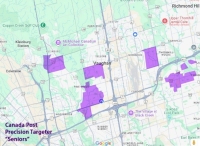Using Data to Drive Awareness & Attract New Users
Vaughan Public Libraries
Innovation Synopsis
Libraries provide remarkable value to customers, and once a person is part of our ecosystem, we have many free or low-cost ways to communicate our collections, services and programs. From in-branch posters to newsletters and conversations with staff.
Attracting new customers can be far more problematic, due to a fractured media landscape, limited promotional budget, and a crowded marketplace for attention.
Through leveraging data and spending wisely, Vaughan Public Libraries (VPL) was able to create an innovative marketing campaign that directly targeted our most likely potential customers, across multiple channels, in their neighborhoods and in their daily movements around the city. This led to an increase in library card registrations and website traffic.
Challenge/Opportunity
• Vaughan is a city of 350,00 people, with 14 library locations. Rapid growth has seen it double in size over the past 25 years, and while there are 83,000 active library users, it’s clear that there’s strong potential to expand that pool.
• The marketing share of VPL’s annual budget is 0.6%, and half of this figure is spent on library cards and the print costs of a bi-monthly programming magazine. The remaining amount covers everything from promotional items to signage, which means that dollars spent on external communications and promotions to non-customers are extremely limited.
• To increase our bang for the buck, we looked at best practices in other industries, dug through our own data, and worked with our partners to create a holistic strategy for raising awareness of library services amongst the people most likely to respond. From analyzing our customer base, we saw that we under-indexed with young families and older adults when compared to their population size in the city.
Key Elements of Innovation
• We aimed to reach audiences that had the lowest % of library members., and using data from Environics Analytics, we were able to determine the best audience segments to target, based on demographics, behavioral patterns, segment size, and market penetration.
• This data could then be mapped to City streets, showing the neighborhoods that had the highest percentage of these audiences. Using Canada Post’s tools, we were able to target a postcard campaign that had maximum coverage of these streets while omitting areas of lesser interest.
• All ad design and copy were developed to appeal to the selected target segments based on their demographic and behavioral characteristics.
• Based on the geographic distribution of our target audience, we expanded our reach by placing ads across transit networks and roadside billboards. These placements were designed to raise public awareness while also reinforcing our direct mail campaign, helping to increase top-of-mind recall among recipients.
Achieved Outcomes
Our campaign succeeded in driving awareness of library services, by getting into neighborhoods that had less library users than average, allowing us to spend our limited budget where it had the most potential upside. It also translated this awareness into new customers.
• 39,300 households received a targeted postcard promoting the most relevant services, programs and collections.
• 230,600 impressions (views) from transit users on routes that pass through our target neighborhoods.
• 115,300 impressions from roadside advertising in our target neighborhoods.
• 4,500 impressions from Google Search advertising, geotargeted to the same areas.
• Using Google Analytics, we saw that the webpage we used as our call-to-action (new membership) nearly doubled the number of visits from the same time last year.
• New library card registrations increased 60% over the duration of the campaign.
• We encouraged online library card sign up for transit users and saw a 45% spike during the campaign.



